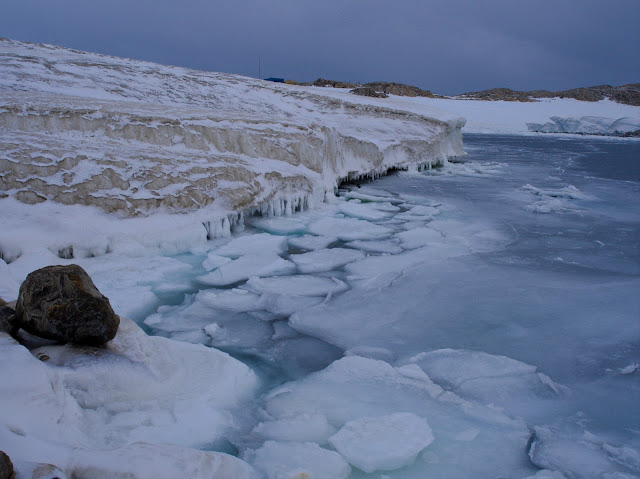Having just arrived on station, I am not yet field trained. Meaning I am not yet free to get out and about and recreate in the surrounds of Station.
My winter crew however, all completed training during in the summer, and have since been too busy with the summer works program to take many field trips.
So in this, my second weekend on Station, there was an exodus.... I won't take it personnally!
Three of the Aviation team are up at the ice runway at Wilkins still winterising the runway and packing up the aerdrome. Six expeditioners planned a weekend to Browning Peninsula 70 kms away, and a further five deceided to spend Saturday night enjoying the open fire of the Wilkes Hilton at the old abandoned Wilkes Station on the Clark Peninsula just across Newcomb Bay from Station.
This left eight of us here on Station. Our on duty fire team, the on duty Bureau of Meteorology (BoM) observer and myself.
In a station that has the capacity for 100 expeditioners, let's just say that the 8 of us had a lot of quiet time to ourselves!
Our chef was one of the intrepid souls spending his day off at Wilkes, so Ducky, our plumber and I were rostered on as cooking slushies to work the kitchen on Saturday. After putting up a full cooked brunch, we then embarked upon cooking a roast dinner for the crew, helped along by some excellent Slushy FM Tunes. Ducky prepped the lamb and baked some sour dough bread, and I prepped the vegetables.
The honey mustard and peppered roast lamb, roast potaotes, kumara, roast beetroot with yoghurt and dill dressing, and roast garlic was devoured happily, followed by an icecream sundae bar for desssert.
Four of us retreated to The Wallow, the other four disappeared into the vast vacant space that is Casey Station, and we sat and chatted for a little while, as the last of a specatcular sunset faded away outside.
At the outrageously late hour (!) of 1930hrs, I went to play guitar in the cinema for a little while, and when I emerged at 2030hrs, all the lights were off and The Wallow was abandoned.
Only three weeks ago a Saturday night on Station would have seen the tunes pumping, and Spilnters Bar packed full of people, a line up for the pool table and a fiesty darts competion underway.
I couldn't help but think of all of the hilarious scifi movies I'd ever seen, episodes of the X Files, you name it, where something strange has happened on a remote scientific research station... where the main character wanders in to find station abandoned.
Happily the most sinister thing going on here was a bunch of crew that so overindulged in lamb roast that they'd staggered off to their rooms to digest, watch TV shows, or build lego as the case my be.
I followed suit and did the same, on account of not yet having figured out where the light switches are to turn the lights back on!
Oh Antarctic winter life you amuse me!
~~~~~~~~~~~~~~~~~~~~~~~~~~~~~~~~~~~~~~~~~~~~~~~~~~~~~~~~~~~~~~~~~~~~~~~~
The Wallow: The lounge area at the heart of Station complete with pool table, darts, sofas, disco ball...you get the idea
Splinters Bar: The Station bar...No idea why it is called Splinters... standby. I have 6 months to find out!
Slushy: The kitchen hand who helps the chef on a rotating roster. Everyone on Station takes a shift. We have 12 shifts each this winter, two of them are cooking slushies.
Slushy FM: The Slushy's job is to program the station FM radio station, which is played in all of the offices, vehicles and workshops. We are all at the mercy of the rostered slushy's musical taste, or lack thereof for at least 10 hours.
 |
| Saturday night sunset lights up Clark Peninsula. Photo: Jacque Comery |
 |
| The Hagglunds fleet back from their weekend adventures. Photo: Jacque Comery |
 |
| The very vacant muster board. Photo: Jacque Comery |
 |
| Saturday Slushy Team. photo: Jacque Comery |
 |
| Lamb Roast night. Photo: Jacque Comery |




















